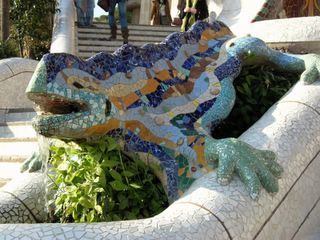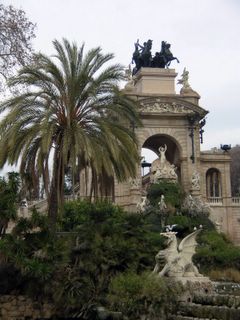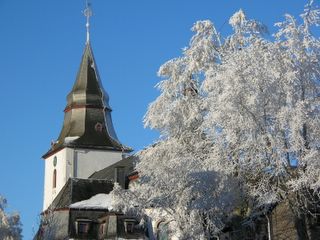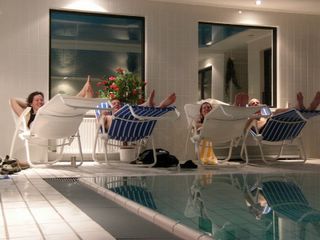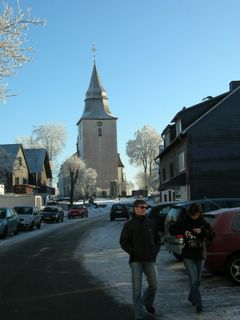I’ve always assumed that my logical and mathematically oriented brain would take to another language like a ditch-digger to dirt. After all, language is just a bunch of grammar and syntax rules that you apply in a uniform and consistent manner, right? What could be easier? I’ve been doing this kind of shit for 15 years in over 10 different computer languages. Why should Dutch be any different?
My expectations for myself and the language were therefore rather high when we first moved to Holland. I bought a phrasebook, a dictionary, and a beginners course on CD-ROM. What I had not anticipated was the fact that 90% of Dutch people are fluent in English. From the very first day in Holland, when we met Peter and Ben on the street in front of our house, we’ve never been in a situation in this country where we could not get by with English. It bulldozed over us. With each passing day, we were meeting and interacting with more and more of the locals, making friends, setting down roots – all in English. No one ever expected us to know their language. After all, we were just Expats, passing through for a year or two. They were always happy - no, let me rephrase that - they were always excited to speak with us in English. It was very good practice for them.
And so the pattern was set. When I was out in the park I would speak English. Sure, I was studying Dutch at home with the books that I brought from America. I thought that it was going well and I would occasionally “dazzle” someone with a phrase or two of Dutch, but any conversations quickly reverted back to English, which was fine with me. We were just getting to know people and even though I had learned the conjugations of verbs and basic sentence structure, I didn’t feel that I could fully express my personality in the language yet. Things were going so well in English.
I still remember the day that I realized how naïve I had been. It was about 6 months after moving here. Beth and I were at the old butter market in Haarlem and we were going to have lunch at our favorite fish stall on the square. I’m sure that the guy behind the booth knew our faces because we’d eaten here so many times before, always ordering in English. But this time it was going to be different. I had been rehearsing all morning exactly what I was going to say in Dutch. I would order us two Cod sandwiches, with mayonnaise and spicy sauce, on hard rolls. Beth would be so impressed. I imagined her looking up at me with fluttering eyes and pouty lips. This was going to be great.
When our turn came, I pulled her up to the counter with me so that she could hear every word of my linguistic talents. I stepped up and confidently delivered my rehearsed lines, which went something like this:
“Ik wil graag twee gebakken stukjes kabeljauw, op harde broodjes. Met mayonnaise and gekruide saus op allebei, alstublieft”
The clerk hesitated, looking at me with a hint of uncertainty in his eyes. But then my heart soared when he pulled two crusty rolls from the bag and reached into the counter for the stack of breaded cod.
Homerun! The grammar was perfect. The sentence structure was fully optimized. The proper syllables were stressed. The inflections of voice were on target and my “g’s” were beautifully gargled. Hrmmph! No problem. I could speak Dutch! I looked over at Beth, beaming with pride and waiting for the payoff look from her. I didn’t quite get the “Oh Dan, what a stud” look that I had daydreamed about, but she did smile back at me with her eyebrows slightly raised.
Then I felt a jab on my other side. An older woman was standing beside me, poking me on the shoulder and pointing toward the clerk. When I turned, she hit me with a long, fast stream of Dutch. I think it was Dutch, but it could have just as easily been Swahili because I had no idea what she was saying or what she could possibly have wanted with me. I was a bit shaken and followed her pointing finger to the clerk. He was coating our sandwiches in mayonnaise, but when he caught my eye he asked me a question. At least I thought it was a question. His voice rose at the end, and he appeared to be waiting for a response. But seeing just more confusion on my face, he stopped giving his mayonnaise bath and repeated the question a second time, looking me directly in the eye.
Nothing. Nada. Zip. Null. Blank stare. In the context of this simple transaction for two lousy fish sandwiches, you’d have thought that I could pull the meaning of a word or two from the heap of sounds that I was hearing. It was truly embarrassing that I had absolutely no clue what he was saying. My confidence was shattered. I took a step back, and punted.
“I’m sorry, but I don’t speak Dutch.”
…
That day was a bit of a turning point for me. I am still convinced that there is some genetic code that makes certain skills easier or harder for different people learn. But I now realize that whatever the code is for a second language, it wasn’t delivered with my aptitude for math. I was going to have to work for this language.
It’s been a very tough road for me, one of the most difficult things that I’ve ever undertaken, full of setbacks and frustration. But the longer that we stay here, the more that I realize how important learning the language is for us to move out of the “temporary Expat” box with our local friends.
That day on the butter market, I set a goal for myself for the next 12 months. It was a vague goal, and would be very tough to measure. But I am now happy to say that I consider that goal met.
I am finally able to hold a meaningful, two-way conversation in Dutch.
I continue to learn and am nowhere close to fluent. I don’t really know if I ever will be. My vocabulary is pitifully small, and I still catch myself making many mistakes. But people no longer automatically switch over to English with me, and even if they do, I continue on in Dutch. After all, I need the practice.
Dan and Beth do Europe! Welcome to our on-line journal of daily life in The Netherlands!
statcounter
#####################################################
Tuesday, January 31, 2006
Sunday, January 22, 2006
A winter holiday

Beth launched her European marketing initiative in Sunny Barcelona last week. I thought that it was a great opportunity to tag along and check out this Spanish city nestled between the Pyrenees mountains and the Mediterranean sea. The broad, sweeping terms that everyone uses to describe Barcelona – beautiful; modern; vibrant - left our expectations high, but somewhat vague. We hoped that there was some depth behind everyone’s collective enthusiasm.
By the end of the first day I understood why it is so hard to more specifically express a perspective of this city. It’s a kaleidoscope of experiences that are seamlessly interwoven with impeccable urban planning and pride. One of the largest intact medieval city centers in Europe, built on Roman foundations, is complemented perfectly by modernistic beachfront developments. Fast, efficient, and cheap public transportation easily whisks you from the mountainous outskirts to the beachfront core and brings the scale of this huge metropolis down to a manageable size.
I will admit that we continue to struggle a bit with the Spanish culture, but that struggle did not detract from the overall Barcelona experience. We LOVE this city.
I took hundreds of pictures, but I’ll limit the blog postings to some of the more interesting and unusual perspectives. Hope you enjoy!
Beach

A new beachfront development in front of the old fishing quarter – Barceloneta. The streets here are so narrow that the sun rarely reaches the cobbled surface – desirable in this hot climate, especially when you are only steps from beach. An old fort and the Olympic game sites are on the mountain in the background.
Cubist
Solar
Gaudi

As an American, the term “gaudy” has come to mean something that is unappealing, or gauche and I admit that I approached Gaudi’s work here with that preconceived notion. At first glance, these buildings did seem a bit strange. But after I took the tour and learned more about his motivations and intentions, the significance of their design became apparent. For example, this one is known as “The house of bones” because of the skull like railings and boney pillars. The entire house is designed as a marine environment and the front, while having many layers of interpretation, was primarily inspired by Claude Monet’s lily pad paintings. The colors on the front are intricately laid tiles. But the real brilliance was inside…

Impossible to capture in a photograph, the interior of this house was a true masterpiece of functional art. Because there are no straight lines in nature, Gaudi didn’t incorporate them into his buildings. His use of different materials was phenomenal and the balance of light and airflow was of primary importance to the living space. Gaudi does not have a lot of buildings in the world, because he was intimately involved in the intricate details of design and construction of each one. They all bear his personal touch.
I am a huge fan of Frank Lloyd Wright with his geometrical simplicity. But after seeing the work of Antoni Gaudi, I can honestly say that I no longer have a single favorite architect.
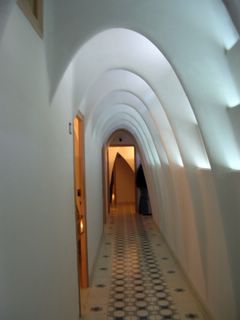
The upper floors of the house were designed with a lighter and airier feel to them - almost like clouds. The light that you see coming into the side of this corridor is natural and comes from a center courtyard that extends the full height of the building. The light here at the top is diffused through these bevels to reduce the heating effect of the Mediterranean sun.
Tapas

Tapas in the Mercat de Sant Josep. These large, covered markets are scattered through every quadrant of the city. You can buy any type of produce imaginable, from hot peppers to full pigs heads. For our friends on the west coast of the US, each one of these markets is like Pike Place market in Seattle on steroids.
Parc Guell

This has to rank in the top three highlights of all of our world travels so far. This place was truly magical. It was financed by a wealthy family as a private subdivision in the hills overlooking Barcelona. Gaudi designed and worked on it between 1900 – 1914. The project never succeeded and all work was stopped after only two houses were built. But the maze of pathways, pavilions, sculptures and terraces that cover the 30 hectares are incredible. I’ve only posted a few pictures, but if you are interested in more just do a simple Google search on Parc Guell and you can see many more.
Las Ramblas
Fountain
Tuesday, January 10, 2006
Winterberg
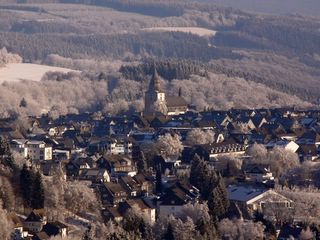
We headed over to Winterberg, Germany for some skiing this past weekend. It is a 4 hour drive from Haarlem and we were all a bit nervous when we still didn’t see any snow after 3.5 hours of driving. Then, out of seemingly nowhere, we crested a ridge and saw the higher snow capped mountains in front of us. All in all, the skiing was pretty good for these parts and once we figured out the electronic lift tickets we were able to get in a lot of runs.
The German countryside in this area is beautiful, with lots of quaint little villages and churches. It stands in stark contrast to the heavily industrialized megalopolis of Essen-Dortmond-Dusseldorf-etc.-etc.-etc.) that we had to drive through….but the autobahns and Sean’s navigating (as opposed to Beth’s) made even that fun.
I’ve posted a few pics from the weekend below.
We’re off to the sunnier and hopefully warmer climate of Barcelona next week so the blog won’t be updated until we get back.
Frosty
By the pool
Tuesday, January 03, 2006
Carnage
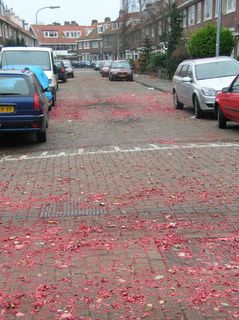
….and the streets were red with…
It wouldn’t surprise me at all if there were some blood mixed in with these spent fireworks casings. It’s our second New Years here and we were once again surprised with the gusto that this holiday is celebrated.
As soon as the sun set, bonfires lit up the streets. Every neighborhood had a favorite corner to gather on, where adults would eat and drink around the fire while their excited children ran rampant through the street touching a match to almost anything that would burn. Fireworks are only legal in Holland for the twenty-four hours on either side of midnight on December 31. The day before we had started seeing roving bands of teenage boys with plastic bags full of explosives. They roamed the neighborhoods setting these crackers off and giggling like girls with every loud burst. The tempo of explosions slowly built up after dark, and then in an eerie prelude to midnight, it almost stopped completely around 11:00 PM.
Just before 12:00 we were standing with a glass of champagne at a large open bay window on the third floor of our friends house looking out over Zannenpark and the double tower steeples of the local church, quietly toasting a new year. When the clock hit twelve the city exploded back into life with a brilliant display of colors and sounds rising above every street. Within 10 minutes, a thick, pinkish smoke hung over the rooftops and diffused the light from the aerial displays. We could no longer see the steeples of the nearby church. At 12:45, the pace of explosions finally started to subside. Holland spent 55,000,000 Euros on fireworks this year and the law says that they all had to be exploded by noon tomorrow. From what we had just witnessed, I think that they underestimated the total, neglecting to count all of the illegal fireworks that were brought in from Belgium.
At 1:15AM Beth and I wished our friends a happy new year and hopped on our bikes for the short ride home. The streets were still smoldering with fires and our bikes stirred up an acrid sulfur stench that hung low to the ground. Littered ruins of parties were scattered everywhere and we had to completely avoid several streets that were blocked or burning with piles of refuse. The explosions continued, now with singular distinctions that echoed through the otherwise quiet streets. It took very little imagination to picture a city tired from war, rather than one tired from celebration.
When we got home, Sage greeted us no more enthusiastically than normal. A loud radio left on had kept her oblivious to the carnage outside. The short walk up to the “pee park” seemed to be all the excitement that she needed.
Beste Wensen! Wishing you the best in 2006!
Subscribe to:
Posts (Atom)







